Why Filet Mignon is the Crown Jewel of Steaks
Filet mignon is a premium cut of beef taken from the smaller end of the tenderloin, prized for its extraordinary tenderness and buttery texture. This lean, fork-tender steak commands premium prices due to its limited supply – each 1,200-pound steer yields only about 12 pounds of tenderloin.
Quick Filet Mignon Facts:
- Cut Location: Psoas major muscle (tenderloin)
- Texture: Most tender beef cut available
- Flavor: Mild, buttery, less beefy than other cuts
- Price Range: $30-$45 per pound retail
- Typical Size: 1-2 inches thick, 2-3 inches diameter
- Best Cooking Method: High-heat sear + oven finish
As one food blogger perfectly captured it: “Filet mignon may bring to mind fancy steakhouses or extravagant price points, but it’s actually surprisingly easy to perfect this steak dinner at home.”
The extreme scarcity drives the premium pricing. While a massive steer provides hundreds of pounds of meat, only a tiny portion qualifies as true filet mignon. This filet mignon comes from a muscle that bears no weight and does minimal work, creating that signature melt-in-your-mouth experience that has made it the most coveted cut in steakhouses worldwide.
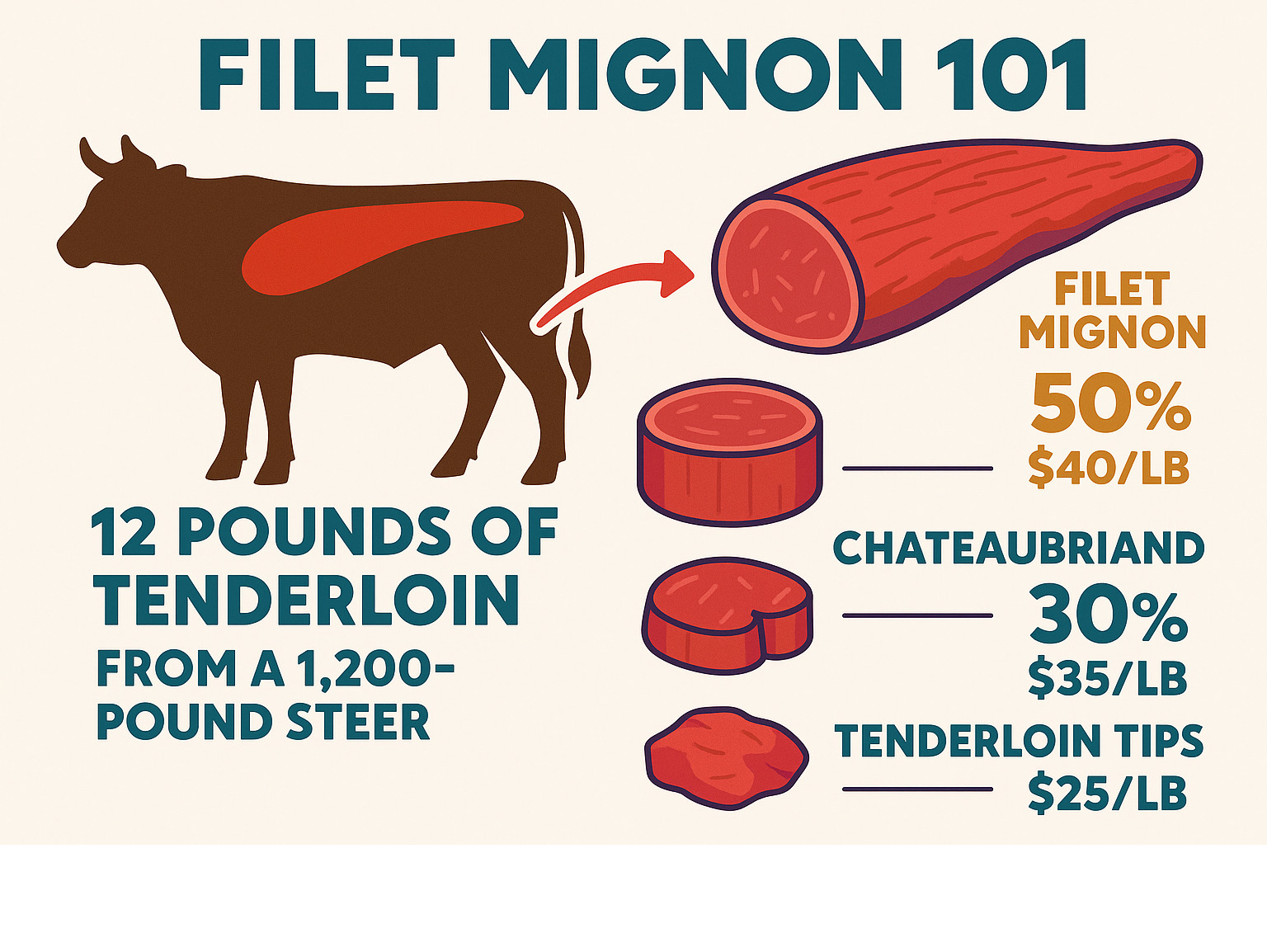
What Is Filet Mignon?
When you bite into a perfectly cooked filet mignon, you’re experiencing the result of fascinating beef anatomy. This prized cut comes from the psoas major muscle, which runs along both sides of the cow’s spine, tucked safely inside the rib cage. This muscle does practically no work during the animal’s lifetime since it’s not weight-bearing, which is exactly why it develops that legendary tenderness.
The French knew what they were doing when they named it “filet mignon” – literally meaning “delicate, fine, or cute fillet.” True filet mignon medallions are cut from the smaller, tapered end of the tenderloin and are typically just an inch in diameter. But most restaurants and butcher shops call the entire middle section of the tenderloin “filet mignon” – those beautiful steaks that measure 1-2 inches thick and 2-3 inches across.
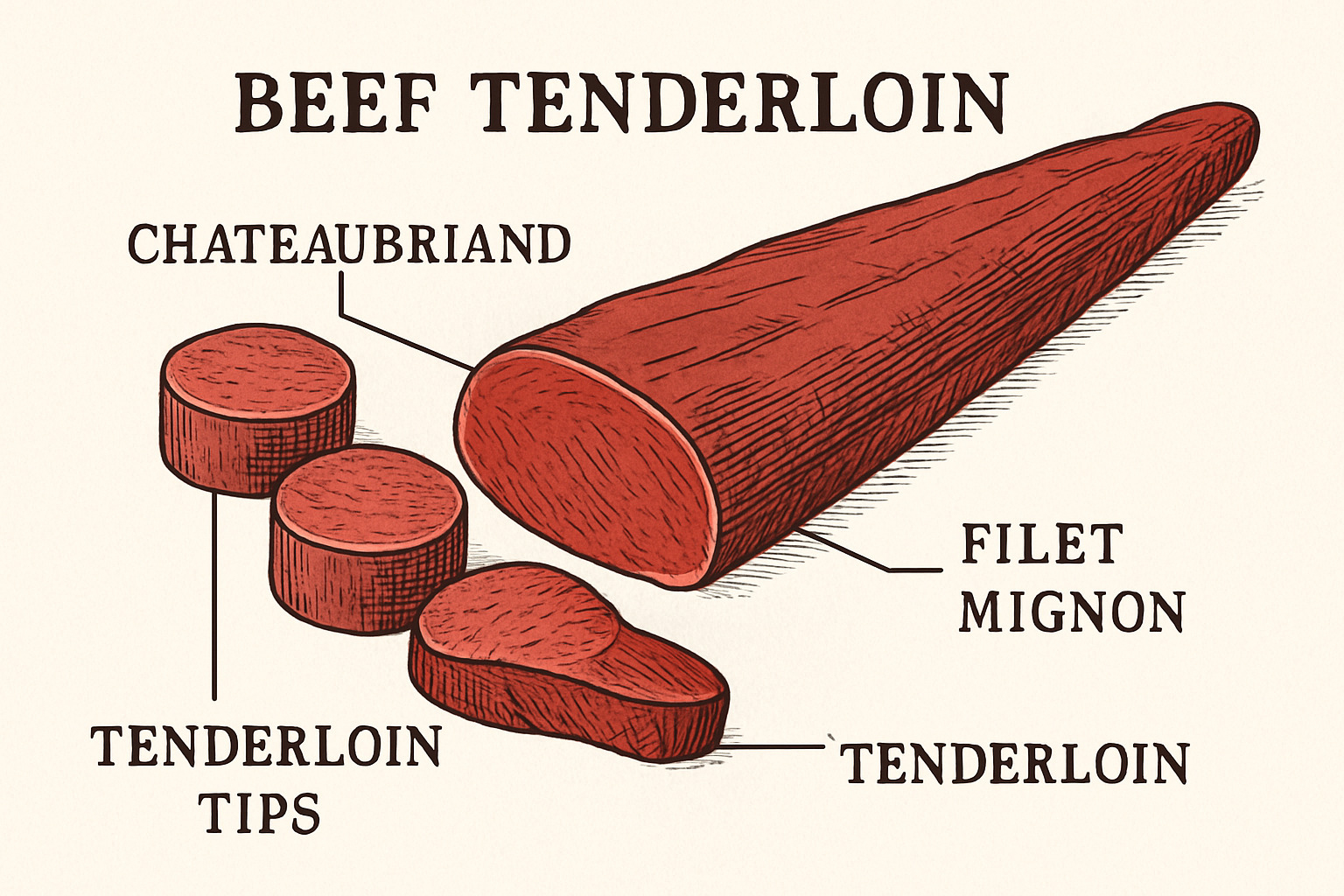
The scarcity factor is mind-blowing. Each animal has only two tenderloins, and just a small portion of each qualifies for filet mignon steaks. The rest becomes chateaubriand or tenderloin tips. It’s this limited supply that drives those premium prices.
Regional naming conventions vary widely. In France, “filet mignon” actually refers to pork tenderloin! French chefs call beef tenderloin cuts “tournedos” or “châteaubriand.” The UK calls it “fillet steak,” Belgium uses “filet pur,” while Spain goes with “solomillo.”
Filet Mignon vs. Other Steaks
Ribeye brings the flavor punch that filet mignon can’t match. While filet mignon wins the tenderness battle hands down, ribeye delivers rich, beefy flavor thanks to its marbling. Ribeye is also more forgiving when cooking, while filet mignon demands precision.
Sirloin is chewier with more bite but delivers stronger beef flavor and costs significantly less. T-bone steaks actually contain filet mignon – that smaller section on one side of the T-shaped bone is genuine filet mignon, while the larger side is strip steak.
| Feature | Filet Mignon | Ribeye |
|---|---|---|
| Tenderness | Extremely tender | Very tender |
| Flavor Intensity | Mild, buttery | Rich, beefy |
| Fat Content | Very lean | High marbling |
| Price per pound | $30-45 | $20-35 |
| Cooking Difficulty | Requires precision | More forgiving |
Filet Mignon Taste & Texture
Filet mignon delivers a buttery, melt-in-your-mouth sensation that’s genuinely unlike any other cut of beef. We’re talking fork-tender – literally. A prime filet mignon can be cut with just a fork.
The flavor profile is surprisingly mild and sweet compared to other steaks. That subtle flavor makes filet mignon incredibly versatile – like a blank canvas that lets sauces and seasonings shine without competing for attention.
Because it’s such a lean cut, filet mignon lacks the rich, fatty flavor of marbled cuts like ribeye. This is why you’ll often see it wrapped in bacon, topped with compound butter, or paired with luxurious sauces like béarnaise. These additions complement the meat’s delicate flavor rather than masking it.
Selecting & Buying Filet Mignon
Shopping for filet mignon can feel intimidating with those premium price tags, but understanding what to look for helps you make a smart investment.
USDA grades are your first guide to quality. Prime grade represents the cream of the crop – only about 2% of all beef earns this designation. Choice grade hits the sweet spot for most home cooks, delivering excellent quality without the premium price of Prime. Even Select grade can work well since this cut is naturally tender.
When examining steaks, look for uniform thickness for even cooking. The meat should be bright red with minimal surface moisture, and avoid cuts with excessive silverskin. Select steaks of similar size so everyone’s dinner finishes at the same time.
Most filet mignon is wet-aged for 14-28 days in vacuum-sealed packages, improving tenderness beautifully. Dry-aging isn’t common with filet mignon because it lacks the surrounding fat needed for traditional dry-aging.
Grass-fed versus grain-fed comes down to personal preference. Grass-fed filet mignon tends to be leaner with slightly more mineral flavor and firmer texture, plus higher omega-3 content. Grain-fed offers the more traditional flavor profile with slightly more tenderness.
Portion sizes typically range from 4-6 ounces for lighter appetites to 8-10 ounces for hearty eaters, with 6-8 ounces being standard.
For those interested in exploring other premium cuts beyond filet mignon, our guide to tomahawk steak offers insights into another spectacular option.
Storage & Food Safety
Protecting your filet mignon investment starts the moment you get home. Fresh filet mignon stays at peak quality for 3-5 days in the refrigerator when stored properly. Place it in the coldest part of your fridge and keep it in the original packaging or rewrap tightly in plastic wrap. Always put it on a plate to catch any drips.
For longer storage, freezing works beautifully for up to 6-9 months. The key is preventing freezer burn by wrapping tightly in plastic wrap followed by aluminum foil, or using vacuum sealing. Label everything with the date.
Safe thawing requires patience. Refrigerator thawing takes about 24 hours for thick steaks but gives the best results. Cold water thawing works for faster results – about 30 minutes per pound, changing the water every 30 minutes. Never thaw at room temperature.
Vacuum sealing extends freezer life significantly and prevents freezer burn. Some butchers offer this service, or you can invest in a home vacuum sealer if you frequently buy premium steaks.
How to Cook Filet Mignon at Home
Mastering filet mignon at home is more achievable than you might think. The secret lies in understanding that this premium cut deserves respect but doesn’t require complicated techniques.
Start with proper preparation – pull your filet mignon from the refrigerator 30-45 minutes before cooking. Cold steaks cook unevenly. Season generously with kosher salt and freshly ground black pepper. For better flavor development, season 45-60 minutes ahead, refrigerate, then pat completely dry before cooking.
Your equipment matters. A cast iron or heavy-bottomed oven-safe skillet retains heat beautifully and creates the searing power needed for that golden-brown crust.
The foolproof sear-and-bake method starts with preheating your oven to 400°F while heating your skillet over high heat until smoking. Add high-heat oil like avocado or canola. Place your filet mignon in the pan and resist moving it. Let it sear undisturbed for 2-3 minutes per side.
Professional trick: use tongs to roll the steaks on their edges for about a minute, browning all sides. Then add butter, fresh rosemary, and crushed garlic to the pan. Tilt the pan and baste the steaks repeatedly with the aromatic butter.
Transfer the entire pan to your preheated oven to finish cooking gently. Remove when your desired temperature is reached, then let the steaks rest under foil for 5-7 minutes. This resting period allows juices to redistribute throughout the meat.
Grilling enthusiasts can succeed with high direct heat for 2-3 minutes per side to develop grill marks, then move to indirect heat to finish cooking. Sous-vide cooking offers precision – set to 129°F for medium-rare and cook for 1-2 hours, then finish with a blazing hot sear.
For deeper insights into achieving perfect doneness, the scientific research on meat doneness provides valuable technical details.
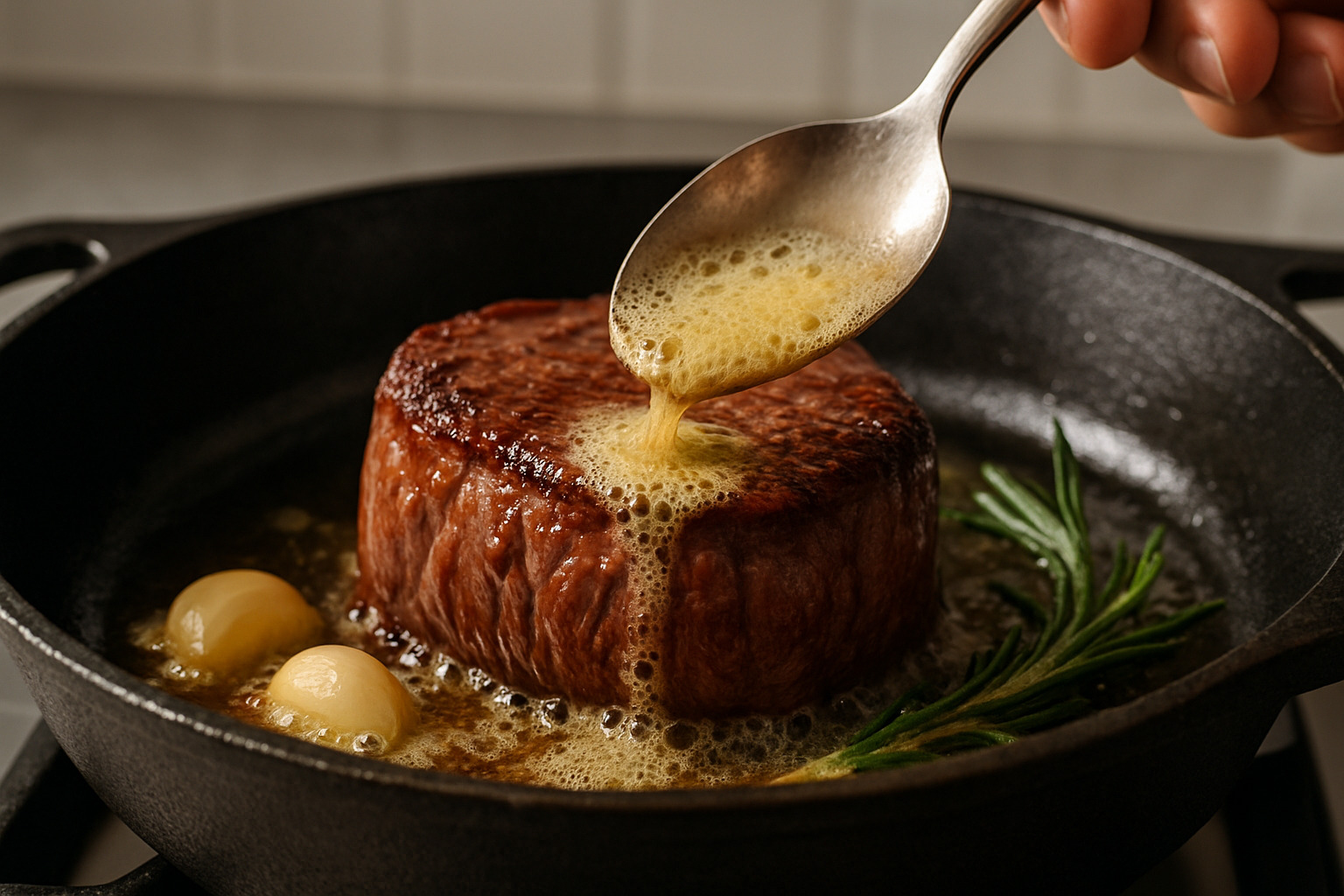
Internal Temperature Guide for Filet Mignon
Getting the temperature right is critical when cooking filet mignon. The secret is understanding carryover cooking, where your steak continues cooking after leaving the heat source.
For rare filet mignon, remove at 115°F and let it rest to 120-125°F. Medium-rare is our top recommendation – remove at 120°F and let it coast to 125-130°F for that perfect warm red center. Medium doneness requires removing at 130°F, reaching 135-140°F during rest. Medium-well means pulling at 140°F to reach 145-150°F. Well-done (remove at 150°F, rests to 155-160°F) isn’t recommended for this premium cut.
Always use an instant-read thermometer inserted into the thickest part. Account for that 5-10°F temperature rise during resting.
Restaurant-Quality Tips & Common Mistakes
The butter basting technique used in high-end steakhouses transforms good filet mignon into something extraordinary. Tilt your pan and repeatedly spoon hot butter over the steaks. Add fresh rosemary, thyme, or crushed garlic to that butter for aromatic complexity.
Never skip the resting period and invest in a quality instant-read thermometer because guessing with filet mignon is too expensive a gamble.
The biggest mistakes: using a cold pan (your skillet must be smoking hot), moving the steak during searing, overcooking (happens fast with this lean cut), being shy with seasoning, and using non-stick pans that can’t handle high heat. Stick with cast iron or heavy stainless steel.
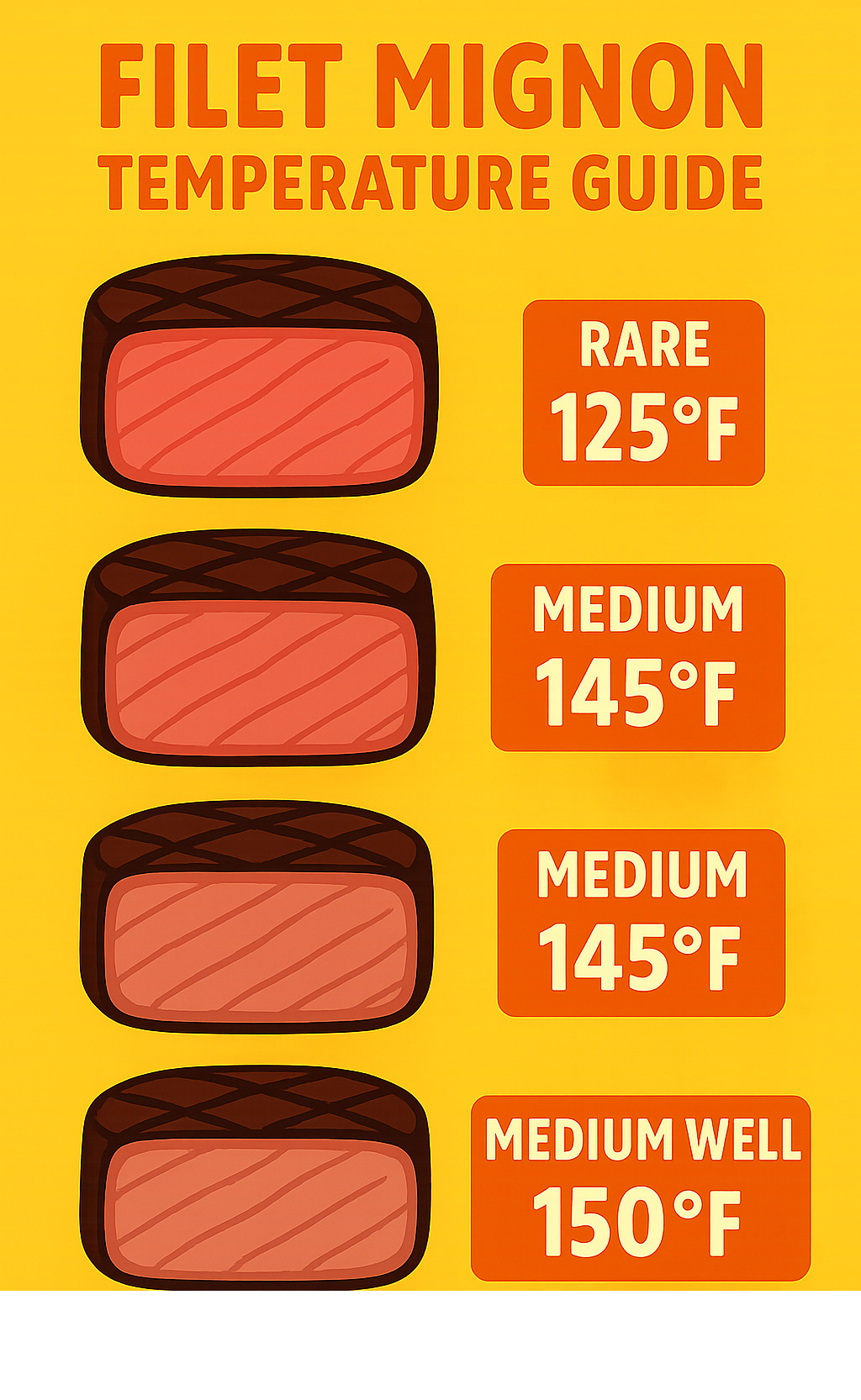
Flavor, Nutrition & Pairings
Filet mignon delivers more than exceptional taste—it’s a nutritional powerhouse. A typical 6-ounce serving provides around 420-450 calories with 42-45 grams of high-quality complete protein. With 22-25 grams of fat, it’s much leaner than heavily marbled cuts like ribeye. You’re also getting 15% of your daily iron needs and excellent B-vitamin content including B12, B6, and niacin.
For wine pairings, Cabernet Sauvignon remains the gold standard. Malbec offers a fruit-forward alternative, while Pinot Noir works beautifully with herb-crusted preparations. Full-bodied Chardonnay is magical with butter-based preparations.
The sauce game is where filet mignon truly comes alive. Béarnaise sauce is the classic French choice, while peppercorn sauce adds creamy richness with spicy kick. Red wine reduction concentrates deep flavors, and compound butter melting over hot steak creates instant flavor explosion.
For sides, think balance and contrast. Roasted asparagus keeps things light, while garlic mashed potatoes provide comforting creaminess. Sautéed mushrooms bring earthy depth, and caramelized Brussels sprouts add wonderful textural contrast.
If you’re interested in exploring how premium ingredients fit into sustainable dining practices, our guide to Farm-to-Table Dining Experiences offers fascinating insights.
Classic & Creative Accompaniments
Traditional steakhouse sides like creamed spinach provide rich indulgence that balances the lean meat perfectly. The classic surf and turf combination with lobster tail remains popular for good reason. Roasted bone marrow takes things to another level, while truffle mac and cheese lifts comfort food to fine dining status.
Modern creative pairings include cowboy butter loaded with herbs, garlic, and spices. Mushroom risotto with wild mushrooms creates a creamy, earthy foundation. Grilled seasonal vegetables keep things fresh and colorful, while sweet potato purée adds natural sweetness.
International inspirations bring global flair. Chimichurri from Argentina adds bright, herbaceous notes. Wasabi butter creates Japanese-inspired fusion, while French red wine jus provides classic pan sauce elegance. Horseradish cream delivers sharp, pungent kick.
Sustainable & International Twists
Grass-fed filet mignon represents the intersection of premium quality and environmental consciousness. These steaks offer higher omega-3 fatty acid content and more antioxidants than conventional grain-fed beef, with better sustainability practices and higher animal welfare standards.
Grass-fed filet mignon has firmer texture with more mineral-forward flavors that some describe as “cleaner.” Wagyu filet mignon, while rare, offers incredible tenderness when available. Dry-aged tenderloin concentrates flavors through careful aging processes.
International preparations showcase how different cultures celebrate this premium cut. French tournedos represent the classic European approach. The American bacon-wrapped style adds fat and smoky flavor. Argentine-style preparations feature chimichurri and grilled vegetables, while Japanese teppanyaki transforms cooking into theatrical entertainment.
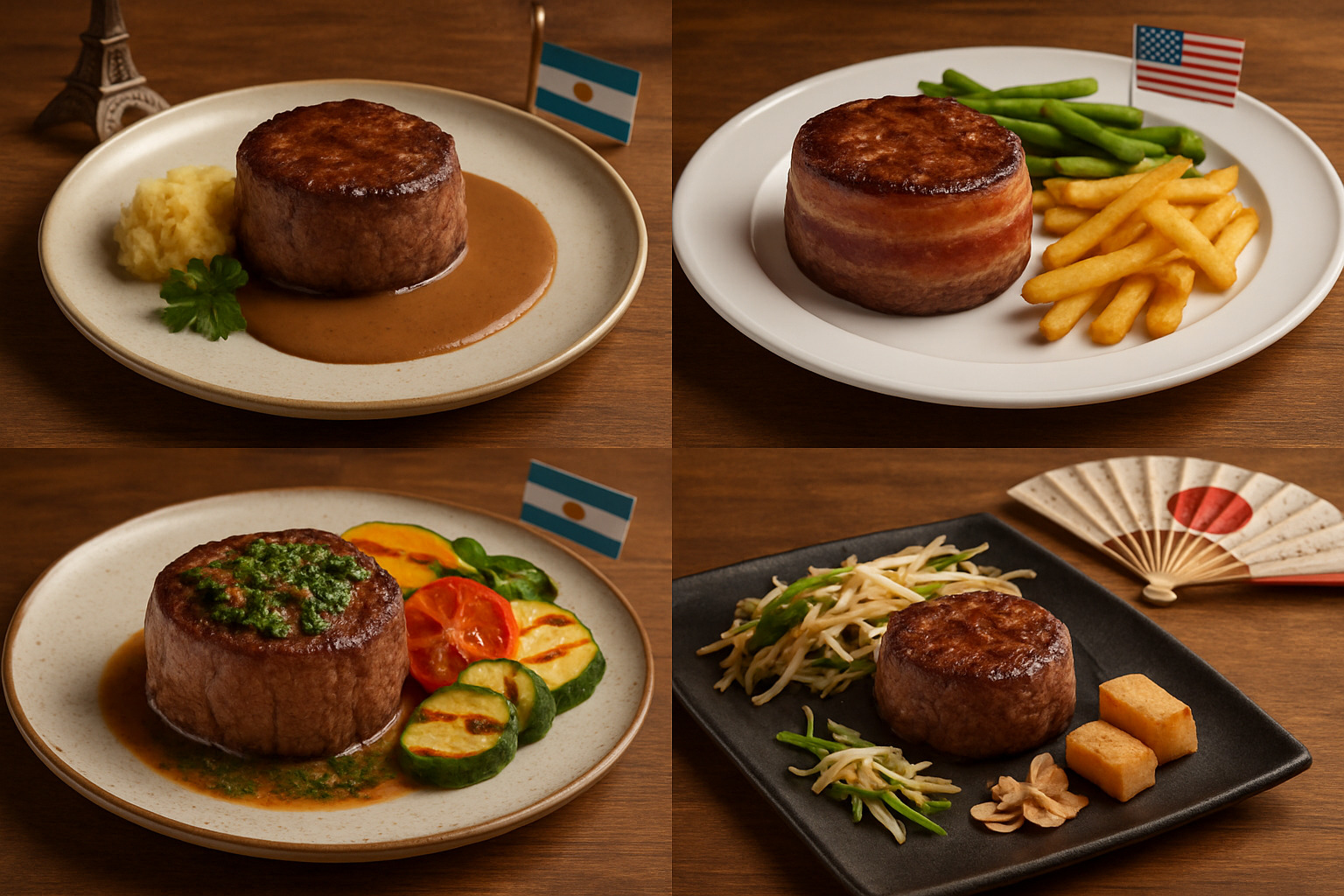
Frequently Asked Questions about Filet Mignon
Why is filet mignon so expensive?
The premium price of filet mignon comes down to one simple truth: incredible scarcity meets exceptional quality. When you consider that a massive 1,200-pound steer yields only about 12 pounds of tenderloin – and just a fraction of that becomes true filet mignon – you’re looking at less than 1% of the entire animal.
This isn’t just any muscle, either. The psoas major muscle that produces filet mignon lives a pretty cushy life inside the animal’s rib cage, doing virtually no work and bearing no weight. This pampered existence creates that legendary fork-tender texture that simply can’t be replicated in any other cut.
Beyond the natural scarcity, there’s also the skill factor. Properly butchering and trimming filet mignon requires expertise, and every step from farm to plate involves premium handling. When you’re paying $30-45 per pound, you’re investing in nature’s most tender cut of beef – and honestly, there’s no substitute for that melt-in-your-mouth experience.
How does filet mignon compare nutritionally to ribeye or sirloin?
Filet mignon stands out nutritionally as the lean luxury option among premium steaks. Compared to ribeye, it contains about 40% less fat per serving, which means fewer calories but also less of that rich, marbled flavor that fat provides. If you’re watching your fat intake but don’t want to compromise on protein quality, filet mignon delivers beautifully.
The protein content is impressive across all three cuts, but filet mignon gives you the highest protein-to-fat ratio. A 6-ounce serving packs about 42-45 grams of complete protein – that’s nearly a full day’s worth for many people. Sirloin comes close in protein content and actually edges out filet mignon slightly in iron content, but you’ll sacrifice that incredible tenderness.
All three cuts excel in B-vitamins, particularly B12, which is crucial for energy metabolism and nervous system health. The main difference lies in the fat content and, consequently, the overall calorie count. Filet mignon lets you enjoy a premium steak experience while keeping the nutritional profile relatively clean.
Can I grill filet mignon without drying it out?
Absolutely, and once you master the technique, grilled filet mignon can be absolutely spectacular! The secret lies in understanding that this lean cut needs a bit more attention than its fattier cousins, but the results are worth the extra care.
Start with a two-zone fire setup – high direct heat for searing and medium indirect heat for finishing. Give each side 2-3 minutes over the hot zone to develop that beautiful crust, then move the steaks to the cooler side to finish cooking. This prevents the outside from burning while the inside reaches your target temperature.
Since filet mignon lacks the protective fat of cuts like ribeye, consider these game-changing techniques: brush with oil or melted butter before grilling, wrap in bacon for added fat protection, or finish with a pat of compound butter. Most importantly, invest in a good instant-read thermometer – guessing with this premium cut is too expensive a mistake.
The key is never walking away from the grill. Filet mignon can go from perfect to overcooked in just a minute or two. With careful attention and proper technique, your grilled filet mignon will rival any steakhouse – and you’ll have the satisfaction of mastering one of cooking’s most rewarding challenges.
Conclusion
There’s something truly magical about filet mignon that goes beyond its premium price tag. This extraordinary cut represents the perfect intersection of scarcity, craftsmanship, and culinary excellence. When you consider that each 1,200-pound steer yields only about 12 pounds of tenderloin – and only a fraction becomes true filet mignon – you understand why this cut has captured hearts worldwide.
We’ve explored the fascinating anatomy behind filet mignon’s legendary tenderness and demystified the cooking process, showing you that with the right techniques and a good thermometer, you can create restaurant-quality results in your own kitchen.
What makes filet mignon truly special isn’t just its buttery texture or mild flavor – it’s the confidence it gives you as a cook and the memorable experiences it creates around your dinner table. Whether celebrating an anniversary, impressing guests, or treating yourself to something extraordinary, this cut delivers every time.
The journey from understanding the cut to mastering its preparation opens up a world of culinary possibilities. Filet mignon serves as the perfect introduction to premium beef cookery, teaching skills that will improve every steak you cook afterward.
At The Dining Destination, we believe great food experiences shouldn’t be intimidating – they should be inspiring. From our perspective here in New York City, we’ve seen how understanding premium ingredients like filet mignon transforms not just meals, but entire approaches to cooking and dining.
Ready to explore where the world’s best chefs are preparing filet mignon and other culinary masterpieces? Our guide to the Best Unique Restaurants will help you find exceptional dining experiences that showcase this remarkable cut in ways you never imagined.
Armed with this knowledge, you’re ready to confidently steer both the butcher shop and the finest steakhouses, knowing exactly what makes each bite so extraordinary.

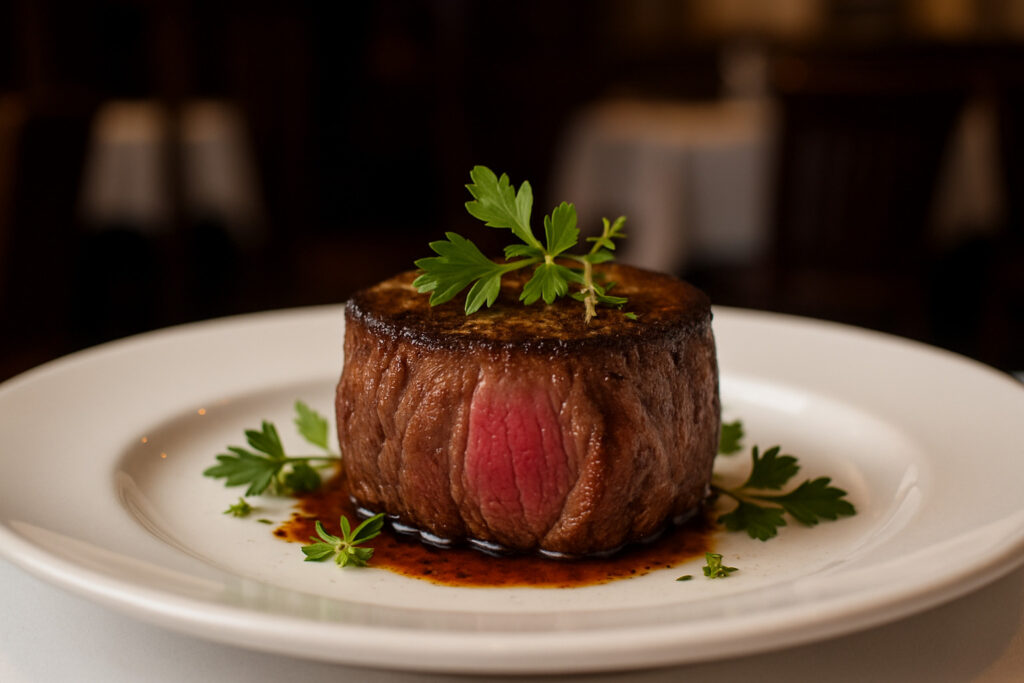






2 thoughts on “Filet Mignon 101: Everything You Need to Know About This Tender Cut”
Pingback: 10 Things to Do Right Now to Improve Your Easy Dinner Ideas - The Dining Destination
Pingback: How to Make Chicken Parmesan in Less Than an Hour a Day - The Dining Destination
Comments are closed.